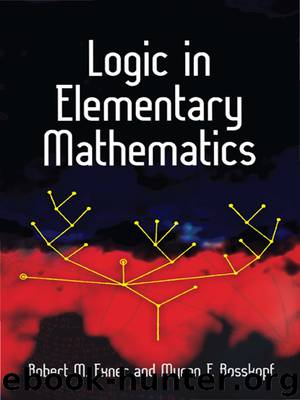Logic in Elementary Mathematics by Robert M. Exner & Myron F. Rosskopf

Author:Robert M. Exner & Myron F. Rosskopf
Language: eng
Format: epub, mobi
Publisher: Dover Publications, Inc.
Published: 2013-04-16T16:00:00+00:00
FIG. 21.
Proof: Call the point “P”. P joins just three lines [A2*], call them “l1”, “l2”, and “l3”.
l1 has exactly two other points on it [A2]. Call them “X1” and “Y1”. X1 is joined to l2 at P [hyp]; so X1 is joined to exactly one other point on l2 [A5], call it “X2” (see Fig. 21).
Similarly, X1 is joined to some point of l3 other than P. Call it “X3”.
Similarly, X2 is joined to a point on l3 different from P, call it “F” (Fig. 21).
We would like to prove that F = X3 so that (X1X2X3) is a triangle. We proceed indirectly.
Suppose X3 ≠ F.
Now, the figure suggests that there are three lines joined by X2. Let us prove that they are indeed all distinct. If (X1X2) is the same line as l2, that is, (X1X2) = l2, then X1 is on l2 and l1 = l2 [T1]. But we have l1 ≠ l2, so we have (X1X2) ≠ l2 [contrap. inf.].
Similarly, (X2F) ≠ l2.
Finally, if (X1X2) = (X2F), then P is joined to all three points of this line, which contradicts “A5”. Thus, there are three distinct lines (X1X2), (X2F), and l2 joined by X2. By “A2*” these are the only lines on X2.
Now,
Download
Logic in Elementary Mathematics by Robert M. Exner & Myron F. Rosskopf.mobi
This site does not store any files on its server. We only index and link to content provided by other sites. Please contact the content providers to delete copyright contents if any and email us, we'll remove relevant links or contents immediately.
| Algebra | Calculus |
| Combinatorics | Discrete Mathematics |
| Finite Mathematics | Fractals |
| Functional Analysis | Group Theory |
| Logic | Number Theory |
| Set Theory |
Modelling of Convective Heat and Mass Transfer in Rotating Flows by Igor V. Shevchuk(6348)
Weapons of Math Destruction by Cathy O'Neil(6073)
Factfulness: Ten Reasons We're Wrong About the World – and Why Things Are Better Than You Think by Hans Rosling(4616)
Descartes' Error by Antonio Damasio(3183)
A Mind For Numbers: How to Excel at Math and Science (Even If You Flunked Algebra) by Barbara Oakley(3176)
Factfulness_Ten Reasons We're Wrong About the World_and Why Things Are Better Than You Think by Hans Rosling(3156)
TCP IP by Todd Lammle(3091)
Applied Predictive Modeling by Max Kuhn & Kjell Johnson(2973)
Fooled by Randomness: The Hidden Role of Chance in Life and in the Markets by Nassim Nicholas Taleb(2961)
The Tyranny of Metrics by Jerry Z. Muller(2949)
The Book of Numbers by Peter Bentley(2868)
The Great Unknown by Marcus du Sautoy(2608)
Once Upon an Algorithm by Martin Erwig(2535)
Easy Algebra Step-by-Step by Sandra Luna McCune(2533)
Lady Luck by Kristen Ashley(2492)
Practical Guide To Principal Component Methods in R (Multivariate Analysis Book 2) by Alboukadel Kassambara(2444)
Police Exams Prep 2018-2019 by Kaplan Test Prep(2437)
All Things Reconsidered by Bill Thompson III(2323)
Linear Time-Invariant Systems, Behaviors and Modules by Ulrich Oberst & Martin Scheicher & Ingrid Scheicher(2301)
